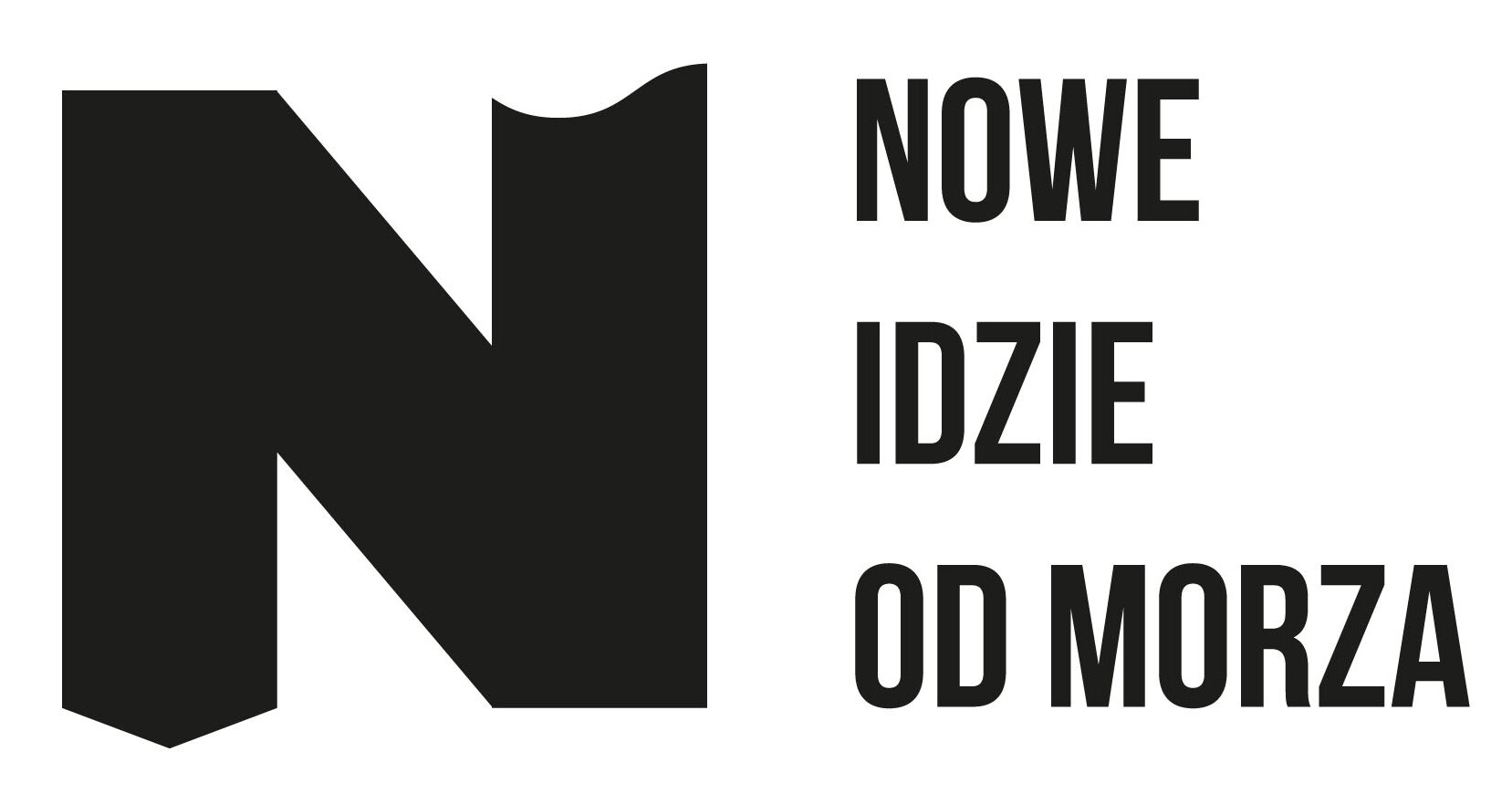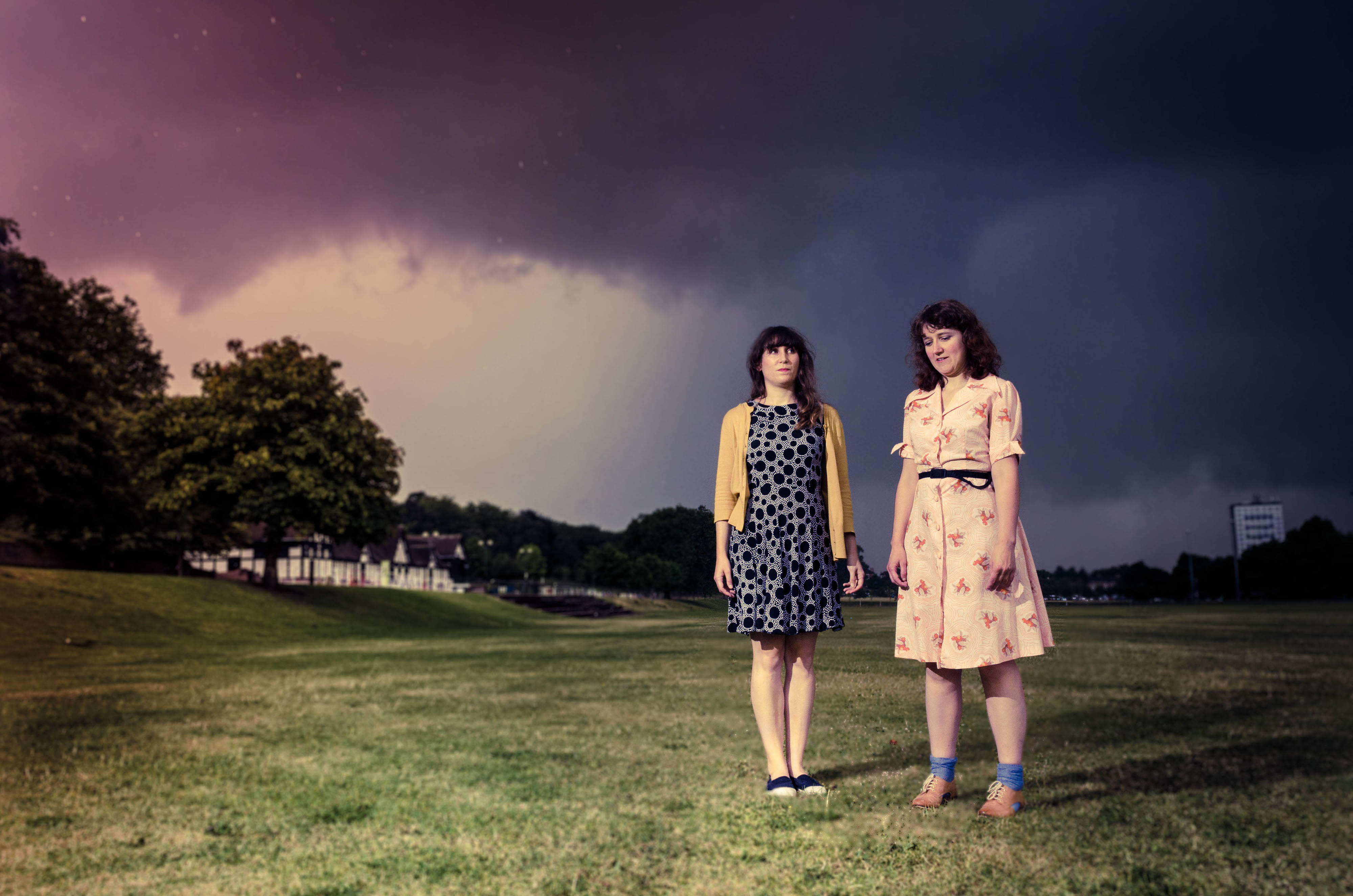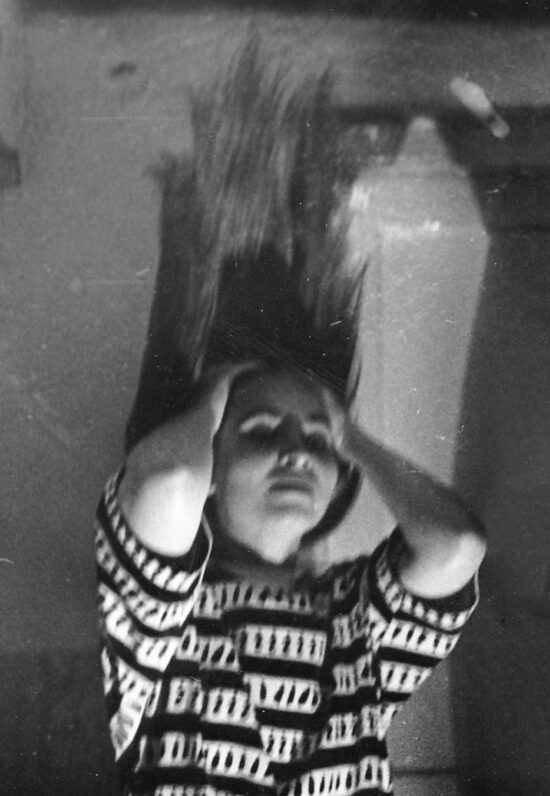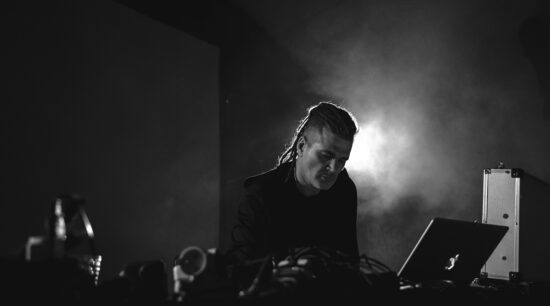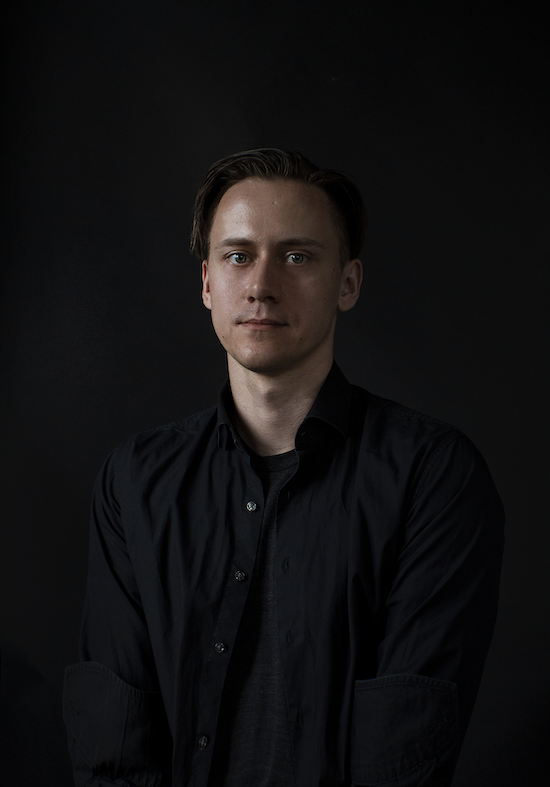“We are drums and we are all about rhythm and getting into that headspace, being quite meditative and obviously repetitive. If you give yourself more time, then you can get into that more, and it’s the same with people listening live – they get more out of it.”
Translation: Aleksandra Szkudłapska / Photo: Simon Parfrement
Using drums as the main source of music has been a popular choice on the alternative stage throughout the past few years. In recent months, this instrument has been put to original and intriguing use by such artists as Eli Keszler or Tigue, to name but two.
Rattle, a duo hailing from Nottingham, also employs two drum sets in a very creative fashion (or one shared drum set, in fact, but more on that below). Katharine Eira Brown and Theresa Wrigley begantheir joint adventure with music in 2011. At first, what they wanted was a skill swap: teaching each other to play instruments they didn’t play in their earlier bands. However, they soon ended up just playing the drums together. The raw repetitions, vocalisations and a witty approach to rhythmic minimalism were what made them instantly recognisable.
We did not have to wait long for the results: in 2016, Rattle released their eponymous debut album, a charming record with its unique emphasis on rhythm, metre and building the tension between the two artists. The band started out playing live in Nottingham and elsewhere in the UK, but in autumn 2018 they went on to complete a massive tour of the US, supporting Protomartyr and Preoccupations. Upset the Rhythm have just released their second album, Sequence, where the duo is even more minimalist with their sound, extending the pieces, throwing in mantra-like loops and repetitions, only sometimes adorned with evocative vocals. In the age of rock bands that attack you with noise and cascading sounds, Brown and Wrigley have adopted a different approach, luring their listeners into a world of music that borders on silence, offering a sparse enunciation of sounds and mantra-like rhythms, which are skilfully deconstructed when one least expects it. We talked about the potential of drums and finding the new sides of this instrument, but also about melody and what it means to skilfully play together as a band.
Jakub Knera: How did Rattle start out?
Katharine Eira Brown: We started getting together, playing the drums and sharing tips for drumming, us both, not necessary wanting to be a band. I asked Theresa whether she would fancy doing some drum lessons in return for me giving her guitar lessons. At that time, she lived with some friends and they had a little practice room in the house. Finally, instead of practicing, we made a bit of music, which I recorded on my phone. We liked it and thought it was worth pursuing. We probably thought that we might invite more people in, I was also thinking that I might end up playing the guitar, but then it just sounded very good that we stayed with drum sets.
But it wasn’t your first band – Katharine was a guitarist who had recently started playing drums in the band Kogumaza and Theresa is the drummer of Fists.
Katharine: We both played in lots of different bands as well. And because of that it felt that Rattle needs to be something a bit different to be worth pursuing, to not just be any normal band that we were already in. We knew that it has to be different.
Theresa Wrigley: We were thinking that maybe we should add something, but at the same time we felt the challenge of it, the fact that we could write stuff that was enjoyable. It took us ages to write something or play a gig when we thought “Oh, we’re on top of it”, but the fact that we didn’t really know what we were doing at first really kept us going. It was fun to start this weird concept.
Katharine: At the beginning no one could understand why we were doing this thing, or was it really just drums. We could do a gig pretty early on and we knew that everyone thought it would be terrible, the bar was set pretty low, so we really could do whatever we wanted to do.
Did you learn to play instruments by yourself or did you have any background education?
Theresa: I’ve played the drums since I was 15. I dabbled in playing different instruments, but I wasn’t really that interested as I am in the drums. I started off by having a drum tutor, and then I just kept going, playing in bands, and taught myself.
Katharine: I have never played the drums before. Theresa is definitely much more taught. She knows drum music and I think I probably do things that proper drummers think “that’s really breaking the rules”, bad practices. But I started playing the guitar at 15 – I got a guitar for my birthday, which I asked for (laughs) and I had a couple of guitar lessons, but I realized I didn’t need them to keep me going because I loved it so much I was playing the guitar every day anyway. The guy who taught me was a lovely man, but he wasn’t really teaching me what I wanted to learn. I understood very soon that I wanted to learn my own way, which is good and bad at the same time. You can be quite idiosyncratic but may not end up being a good all-rounder. These two different ways, I guess, make Rattle what it is.
Do you remember the exact moment when you both played drums and realized “wow, we should keep doing that!”?
Theresa: It wasn’t a complete song. We just started with an idea. Katherine recorded it on the phone and sometimes you sort of don’t think while playing that you would hear it back. So, when Katharine sent it back to me, it sounded really good. For the first few months, we were taking it very slowly. Our first gig was six months after we started out – very early on – but it took us around three years to actually put an album together.
The way you play in Rattle could be seen as very academic, in a mathematical sort of way, sometimes bringing to mind Steve Reich’s “Drumming”. Katherine, you didn’t play drums before, so what interests you so much in this particular instrument?
Katharine: I was quite fascinated by how melodic they were, which I haven’t ever thought. When I played the guitar in bands before, the drummers would ask me how I heard the drums, I also had my favourite drummers that I loved. But as a guitarist I never invested so much time in how my guitar sounded.
I had a guitar which I liked but I never fussed about looking for the best amp or the best pedals, etc. I guess I got quite tired quite quickly of the sound of my guitar and I wasn’t bothered about buying a crazy Fender or something else to make it sound different. But when I started playing with Theresa, I found this melodiousness in drums, it felt like a new way of making music. It was like “oh, this is a whole new world”, a new vocabulary kind of thing. They were less limited.
It’s funny you say it’s mathematical – I guess Tez always works out of what we’re playing, is the kind of, I suppose, the metronome of the band in a way. She’s kind of working it out – for me it’s not part of the process at all, but maybe she will consider her part in that way.
Theresa: I guess when we wrote songs for the new album, they were very free-form. With “DJ”, the first track on Sequence, we didn’t play it the same way twice. As we recorded it, we realized that we hadn’t got it down the way we wanted to. Often we have this tension between something we wanted to sound quite loose, to have this easy-going feel to it – but also to actually play it every time the same and to make sure it sounds good all the time. You have to work out what you actually play and do it again until you realize what sounds good.
What made you decide to divide the drum kits between both of you? Theresa plays high hat, cymbals, cowbell, snare, but also the low floor tom and lows and Katherine the bass drum, toms, and snare.
Theresa: Firstly, if was totally practical. We had to divide it in some way. In Katie’s band, Kogumaza, there are a lot of toms and it was really kind of driven by that. My beats are kind of ornamental, less the kind of a driving beat, more the kind of beats in between. It made more sense for me to play on the snare and cymbals.
Katharine: I didn’t play the hi-hats at that time, so for the first drum lesson I wasn’t even looking at them. Then I started to play the bass drum. I was on the drum kit and then Tez was on a separate chair playing just the snare. At some point she bought a new massive floor tom and we thought “oh, let’s get him involved”. It was a natural process, but in a way, at one point, we realized that we have got to be careful to not keep adding to this. The cool thing was when I passed my driving test and we could start playing gigs in different places than Nottingham, where we live.
I had a very small car but amazingly our set-up fit into it. So, we have the module we can fit, so we can avoid turning up to gigs Phil Collins-style.
Theresa: We had a few gigs and it was important not to put in the sound of each one over the other one. We don’t have two kits, we both share a kit. We make sure that everything fits in with each other, so we try not to play over each other. It works that we have different drums.
You said it was natural – but very often when I see two drum sets, it’s not easy to recognize who plays what, since both drummers play the same thing. Rattle almost sound like one four-hand drummer.
Katharine: We have a portion of songs where we have the rule not to hit something at the same time. Almost always. We usually try not to play the same thing. We don’t need to do it, we rather try to expand something rough.
Theresa: There are some two-drummer bands that are all about the volume that people can make and it’s really great to watch. You see how they hit different things, but sometimes you don’t really hear it.
You use the term “song”. On your debut album Rattle from 2015, your compositions were shorter, you both sing, they kind of follow the song format. What do “songs” mean for you?
Katharine: You mean in relation to vocals or making songs in general?
In general. Playing or practising music is one thing, but to make structure of it is another. Is structuring the idea the meaning of “song” for you or is it anything else?
Theresa: I think both really. These are stages you are going through.
Katharine: I think I get the extra point when I’ve got to go away to do the vocals, then finetune that structure.
Theresa: We usually have an idea of something between us. Katie is going to write lyrics and when she brings it back to me, it makes more sense. I can hear it as a song a little bit more. Because at the beginning it sometimes sounds like a collection of beats. On the new album it’s taking shape just when Katie is putting the vocals.
Katharine: It’s turning into a song when the vocals are there. They change from being something experimental for a while to “oh, this is actually a thing now and this is what it sounds like”.
Theresa: It’s set then and you can’t go back.
Katharine: The song is when you can repeat it many times. It’s obvious that the changes could be made very often. Words are to complement what Theresa and I are playing. She’s listening to that and we sometimes change what I’m playing on drums. She can adapt what she’s doing a bit more to see the vocals and my drumming is gone off a bit. My vocals and Tez sound together.
How did it happen that compositions on Sequence are longer that on Rattle? There are just four pieces, but each lasts around 10 minutes.
Katharine: It’s quite natural. We probably had some practice recordings where we were playing for a long time and I already started writing vocals to those versions. In the other band I play, Kogumaza, I’ve always played really long songs. I’m used to it and I love long films, long takes… Time can pass when I experience this. I might think it just three minutes or something like that and in reality it’s an hour or longer.
Theresa: I think it was the right thing to do, especially when we played live. I was thinking that maybe we can’t play such long songs and we needed to do short ones. But then we saw that the people are getting into those and it works. This is the idea.
We are drums and we are all about rhythm and getting into that headspace, being quite meditative and obviously repetitive. If you give yourself more time, then you can get into that more, and it’s the same with people listening live – they get more out of it. That makes more sense.
Of course, I can play drums for hours, sometimes it’s something really boring (laughs). But the point is to choose the stuff which could be a good starting point and add something to it. The more we did the longer songs, the more it was obvious that they should have that structure.
It reminds me a bit of the idea of Deep Listening formulated by Pauline Oliveros. After each repetition, I’m more and more into it. There is also the interplay between you both – I can hardly imagine that you don’t record it at one take together.
Theresa: We couldn’t have done it with each of us having separate tracks!
Katharine: They are quite long songs and we might get tired at one point and then it changes everything. But for the album we’ve always recorded together live. But later we add the vocals on the top. We did try once to record separately – Tez is a very good drummer who can play properly and if I was like that, we might have tried recording it bit by bit. But I’m the weakest link, I know my limitations. I also know that Mark Spivey, who recorded us, wanted to record us that way – it’s easier to edit separate tracks. But the way we play together is more interesting to record it at one take.
Theresa: We tried to get some of the feel of a live show and way of playing to the album. These parts when we are kind of going haywire, these low beats where we kind of feed each other as well, they wouldn’t really that much sense if we weren’t playing together.
Katharine: The tempo is naturally changing and it’s not like you can set the speed in which Tez and I’ll go or vice versa. There is this human element which makes it more interesting to records together.
You are playing to yourselves and reacting to each other, it’s also interesting to see you play live, when you’re looking directly at each other face-to-face. The live sound is also important as Mark very often assists your live performances, adding some extra sounds to your music.
Katharine: Mark plays in Kogumaza and he’s always done live sound. When we started playing as Rattle, we wanted to try having him with us to see how it goes. He’s very rum with that really, in a complementary, reserved, suiting-it kind of way. He’s got something called the wedge, which he loves doing. He adds effects to the vocals and to the drums. We play differently when we he’s doing our live sound. There’s definitely something that he adds in terms of the kind of atmosphere and we definitely play differently with him, in a good and positive way. We realized that when we tried to record our music dry, without him there.
Theresa: He’s like a kind of acoustic noise. There’s so much space in between what we do, and it would be too harsh without anything. He adds a bit of warmth to it with the effects. He often uses the delay. We don’t play exactly in time with each other because we’re almost consciously going by his delays as well. We also feed from what he’s doing, apart from listening to each other as well.
Katharine: We still do play acoustic gigs, sometimes it does not work to play with PA. We started playing with just a room with drums and vocals. But very often we play with bands in venues quite big for the set-up we have. So, it’s really great to have Mark bringing out the best sounds with his effects and working with the acoustics and the space more.
Your sound is very pure, I can even imagine you playing your music in the natural environment. There are some effects on vocals or a reverb on drums, but you don’t need any effects, such as amps or pedals on the guitar.
Katharine: This is what’s very exciting about it. I played so many gigs as a guitarist I couldn’t enjoy because there was something wrong with the guitar or I had an awful sound engineer. Sometimes people would even come up onstage to change the sounds on my guitar. I had to compromise the sound that you hear with the sound you release to the audience. When I started playing the drums, I realized that there’s no way I couldn’t hear the drums – they are right in front of me. But what’s also great is the fact that they sound different every time I play. I often play on borrowed drums or using some elements of a borrowed backline, or I play in a different room with a different acoustic space. You’re not doing something when you’re always trying to make you sound the same way, which was how I felt when I played the guitar. If it didn’t sound how I wanted it to sound, it was a failure, but this time I’ve got such a minimal setup that I can embrace it whatever the room is. I found it with the singing as well – if I do it how I want to do it, I’m bringing these things together in the best way. I tune the sound to the particular space and not worry about how the song should be. For me it’s so much more exciting comparing drums to the guitar.
On the record you’re singing “put your ear to the ground / it’s an incredible sound”. To me, this means discovering the potential in drums and its varied gamut of sounds. The pure sound of the drums is really inspiring.
Katharine: That’s true! When I started playing the drums, my certain first thought was: what I’m making here are melodies, I never thought that what I would be playing on the drums would be a melody kind of thing. I was also thinking that every drum beat could be the same, but it can change and sounds different. We are trying to encourage people to listen differently.
Sequence is out now by Upset the Rhythm.
Listen 🎶 Tidal 🎶 Spotify 🎶 Deezer 🎶 Apple Music.
